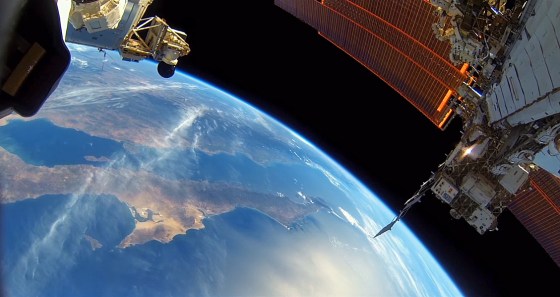In the new IMAX film “A Beautiful Planet,” Jennifer Lawrence speaks over epic footage taken from the International Space Station. While the station's astronaut crew might not have “The Hunger Games” on their resumes, they steal the show, serving as the movie’s stars, cinematographers and camera people.
NASA astronaut Kjell Lindgren has plenty of experience taking impressive pictures. He has shared snapshots from the space station and photos of stunning landscapes with his more than 64,000 followers on Twitter.
But shooting for IMAX was a totally different experience. His work would be displayed on screens that stretch at least 72 feet across, not on tablets and phones. And there would be no professionals to hold his hand on the space station.
Read More: Dramatic Photo Captures Lightning Strike from Space
"It took a lot of courage on the filmmakers' part, because they trained us, and then it was up to us to capture images for them," Lindgren, now safely back on Earth after 141 days in space, told NBC News.
Not only did Lindgren and his fellow astronauts have to be trained to work with IMAX camera equipment, they also had to be taught cinema basics.
"Essentially, we went through a mini film school," he said. "There was a lot of technical training, but we also learned cinematography and about focus and lighting and everything else we needed to make the shots successful."
While all of the astronauts on the ISS were involved, Lindgren said that he, Barry "Butch" Wilmore and Terry Virts took the lead when it came to playing director. That meant getting shots of the crew hard at work inside of the space station. In the movie, astronauts are filmed as they float in tight quarters, eat space lettuce for the very first time and celebrate the holidays.
It might seem invasive to outsiders, like some kind of space reality show, but Lindgren said the astronauts are used to being filmed.
"We have cameras running on the station 24/7," he said. "You're basically living in a fishbowl."
The video feed is used to keep NASA in the loop about what is happening aboard the ISS and provide the public with a look at what an astronaut's daily life is like.

"Everyone once in awhile, when I'm talking to a friend, they will mention that they saw me doing something a week or two ago," Lindgren said. "I'll be like, 'Wow, I didn’t realize anyone was watching.'"
Read More: Amazing Pictures from the Year in Space, 2015
While interior shots are a big part of the film, it's the dramatic views of Earth that really stand out on the IMAX screen. To shoot them, Lindgren and his colleagues shot from two locations. One was the through a window in the lab, which was the choice for direct shots. The other was through the the dome-shaped observational module known as the Cupola, which Lindgren said was used for "more oblique shots."
During filming, he said his "favorite experiences were looking out the window and just trying to be in the moment.
"It’s such an amazing view," Lindgren said. "The views are constantly changing, with different lighting and seasons and weather systems. I would say we’re almost desperate to share that experience."
Many of the scenes in "A Beautiful Planet" aim to show how human beings are changing their home. In one, brightly lit South Korea is contrasted with its neighbor, North Korea, cast in almost complete darkness. Other shots show the effect of climate change, with melting glaciers and the dry California landscape.
Some scenes, however, simply revel in the view from 250 miles above Earth's surface. Lindgren's favorite shot? It was captured using a time-lapse technique over Florida by Wilmore, showing the "turquoise blues of the Caribbean in the moonlight."
Being an astronaut isn't always so idyllic. The film also delves into the terrifying nature of spacewalks. There have been several close calls in the past, including a mission that was cut short after water leaked into an astronaut's helmet. But even spacewalks that go according to plan are scary.
Temperatures swing from 250 degrees Fahrenheit in the sun to minus 250 degrees in the dark. Astronauts have to navigate the exterior of the ISS, with protruding sharp metal parts, without becoming disoriented.
"People have a very romantic vision of the spacewalk," he said. "They think it’s opportunity to just float around and enjoy an amazing view. And it’s true, it is an amazing view. But it’s the most dangerous thing we do."
Read More: Coming Home: A Look Back at Scott Kelly's Year in Space
Now that Lindgren is back on Earth, he doesn't have to worry about the dangers of space. He said that he would love to be involved in more projects like "A Beautiful Planet," but isn't planning to ditch his day job and move to Hollywood anytime soon.
He hopes the film will inspire future astronauts and send a message about protecting the environment.
"The ISS is a microcosm of the Earth," he said. "You have consumable resources, and you have to be mindful of how you use those resources. It reminds us that we have to be better stewards of what we have, and be better crew members of Spaceship Earth."

